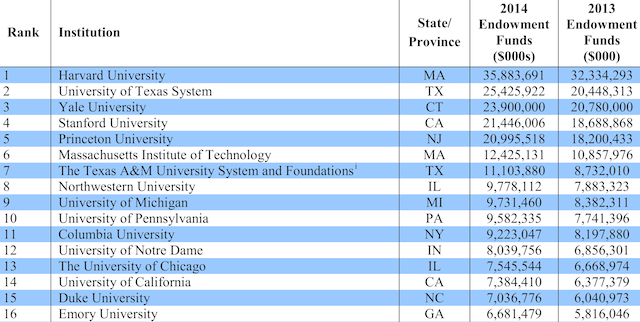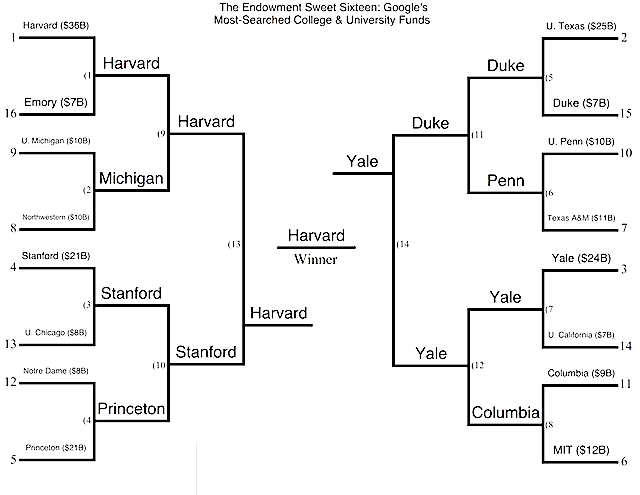The bright young asset-owning hotshots on CIO’s latest Forty Under Forty ranking disagreed on plenty—optimal fee models, manager diversification, Scotch versus bourbon etc. But among those we could wrestle a straight answer out of, their career ambitions were about as diverse as the typical investment conference: “One day, I’d love to be CIO of a foundation or endowment”—zzzz. Sorry, was that, “head of a gravely underfunded US public pension system?” No? Just kidding. We know.
Similar to coaching college sports, managing a top-tier endowment portfolio often means being paid a lot of money to do the thing one’s passionate about for a cause he or she believes in. It’s a position people tend to depart with either (a) an inscribed gold watch and vested pension or (b) a severance package and bad taste in their mouth. Keep performing, and you’re welcome for life. Fall behind your peers for a few too many seasons, and prepare to pack up your things.
The endowment CIO equivalent to March Madness—July Judgment?—might look something like this: The largest “Sweet Sixteen” funds going head-to-head on a more institutional time scale, i.e. over 10 years.
.jpeg)
Endowments: A Private Sector
But like opponents and referees, the behavior of fellow endowments and boards are out of a CIO’s hands. They’re charged with devising an optimal strategy with the resources available—but even that is subject to forces beyond an investment chief’s reach. What endowment chiefs can control is access to the playbook.
Enshrined regulation and powerful stakeholders offer US public and corporate pensions the choice between transparency and extra-transparency. Likewise for insurance general accounts (for whom a wild portfolio move might be a 10% private equity allocation and a decision to not capitalize the ‘T’ when reporting its US Treasury bonds). Freedom from constant public, political, media, and analyst scrutiny adds to the appeal of endowment investing. For all the tough questions fired at an Ivy League CIO during board meetings, at least “Why aren’t we all-passive like Warren Buffett says?” probably isn’t among them. Nor is the grilling webcast to the world.
But tipping one’s hand has its advantages. Had Yale University CIO David Swensen kept the manuscript for Pioneering Portfolio Management locked in his desk (or brain), the Yale Model might just be Yale’s model. Furthermore, without the Yale Model, Swensen may not have had his pick of top-tier talent to help run his investment office—and, later on, nearly every other large endowment as well.
The game-changing New Haven, Connecticut shop has every quality that one imagines would vault an endowment to popular fame: A phenomenal track record, legendary leader, industry standard-setting strategy, vast wealth, and famous name.
But in terms of who’s getting the most love online over the past decade, only the last two features actually matter.
It’s All About Ivy (Plus Stanford)
The surest route to becoming a Google-famous endowment? Belong to the Ivy League and don’t be Cornell. Stanford works, too.
Fund returns, institutional transparency, and CIO longevity appear to count for much less in the long-term online fame game than size and that all-important botanical classification.
This is based on Google Trends data covering the 16 largest endowments, as ranked by their June 30, 2014 market values reported in the latest NACUBO-Commonfund report. Fund popularity is evaluated via aggregated Google searches for each investment organization’s official name, school name plus ‘endowment’, and well-known acronyms and alternate titles. (For example, Duke’s web presence = searches for ‘Duke endowment’ + ‘DUMAC’ + ‘Duke Management Company’.)
 Source: National Association of College and University Business Officers and Commonfund Institute
Source: National Association of College and University Business Officers and Commonfund Institute
The $1 billion prize Buffett and Berkshire Hathaway put up last year for a perfect March Madness bracket had rather long odds: Between one in 4.3 billion and one in 128 billion, depending on who was estimating.
July Judgment, not so much. Revamping the endowment bracket to compete on 10 years of Google search popularity produces a Final Four that looks a lot like NACUBO-Commonfund’s Top Four: #1 Harvard, #2 Yale, #3 Stanford, and—the sole wild card—#4 Duke, which ranks 15th in size.

One suspects Buffett won’t be putting $1 billion on the line for this tournament.
Traffic Tip-offs of Insider Info
Shorten up the backtest, though, and web search patterns suggest nonpublic information may not be all that private in the days leading up to major announcements.
Last spring, for example, either gossip was spreading about Jane Mendillo’s coming departure—revealed by Harvard press release on June 10, 2014—or those in the inner circle were Googling up a storm in the week prior. Searches for Harvard’s endowment and Mendillo topped those for Yale’s fund and Swensen by roughly a third over the six-and-a-half year period beginning just before her appointment and ending two months after revelation of her impending exit. But that spread leapt to two-to-one in favor of Mendillo and the world’s largest endowment in the first week of June 2014.
Harvard did manage to keep a tighter lid on news of her successor, Stephen Blyth—or at least on the digital habits of those in the know. The Yale/Swensen to Harvard/Blyth search ratio stayed perfectly normal up until the press release dropped, after which traffic predictably exploded in favor of the latter.
Harvard’s leadership change may have been the most high profile post-secondary investment shakeup of late, but far from the only one. Among the largest 15 endowments—Emory excluded for not reporting—half of the CIOs leading funds with sub-50th percentile 10-year returns lost or quit their jobs in the past two years.
The University of Pennsylvania—ranked 12th for the decade—replaced CIO Kristin Gilbertson in April 2013. Since then, the University of California (15th place), Harvard (11th), and Stanford (8th) have all followed and replaced their investment chiefs.
Among top-half performing endowments, not one changed leadership.
Sharing ≠ Caring
The two endowment-world CIOs with the greatest staying power (and greatest career track records) share a rare trait within this most private sect of asset owners: An appetite for transparency and public engagement. Swensen and Notre Dame CIO Scott Malpass are both closing in on their 30th anniversaries with their institutions, and, by all indication, enjoy less career risk than anyone in the game.
Notably, Malpass’ willingness to act as a public face has made no discernible impact on web users’ interest in the Catholic endowment. Notre Dame made the return bracket’s Final Four but didn’t come close to advancing from of the first round of Google’s popularity contest.
Yet the much-admired CIO sees advantages from public relations that aren’t necessarily quantified in web traffic—but, in his view, contribute to that stellar performance.
“I’m aware that public engagement has benefits for Notre Dame,” Malpass told CIO last October. “It’s great branding. Top-tier investment organizations look to partner with the best institutions, and we’re often asked to be part of that group. In part, that’s because we’ve developed a reputation as willing to talk about what we’re doing.”
While a web search for Malpass turns up much richer results than for essentially any of his peers, users still fruitlessly pursue his Ivy counterparts much more frequently. After 13 years atop the Columbia Investment Management Company, for example, Narv Narvekar has yet to grant a single published interview. You wouldn’t know it from Google search traffic, however.
One longtime endowment industry player has a theory about this curious inconsistency among veteran CIOs: A few are celebrities, others choose to be hermits, and all are enormously successful.
“Investment is a lonely practice. It’s not a terribly social thing. In my experience, people who are in charge of large endowments are not broadly speaking very social people. They are intellectuals who like solving the problem set before them: optimizing the endowment over time. Because investing is a zero-sum game, they’re not terribly interested in explaining what they’re doing. And if they’re not doing well, they are especially not interested in explaining why.”
Related: Google Trending Part I: Paulson v. Ackman, Bridgewater v. AQR: Who’s Trending on Google? & Part II: Smart Beta’s Google Problem
